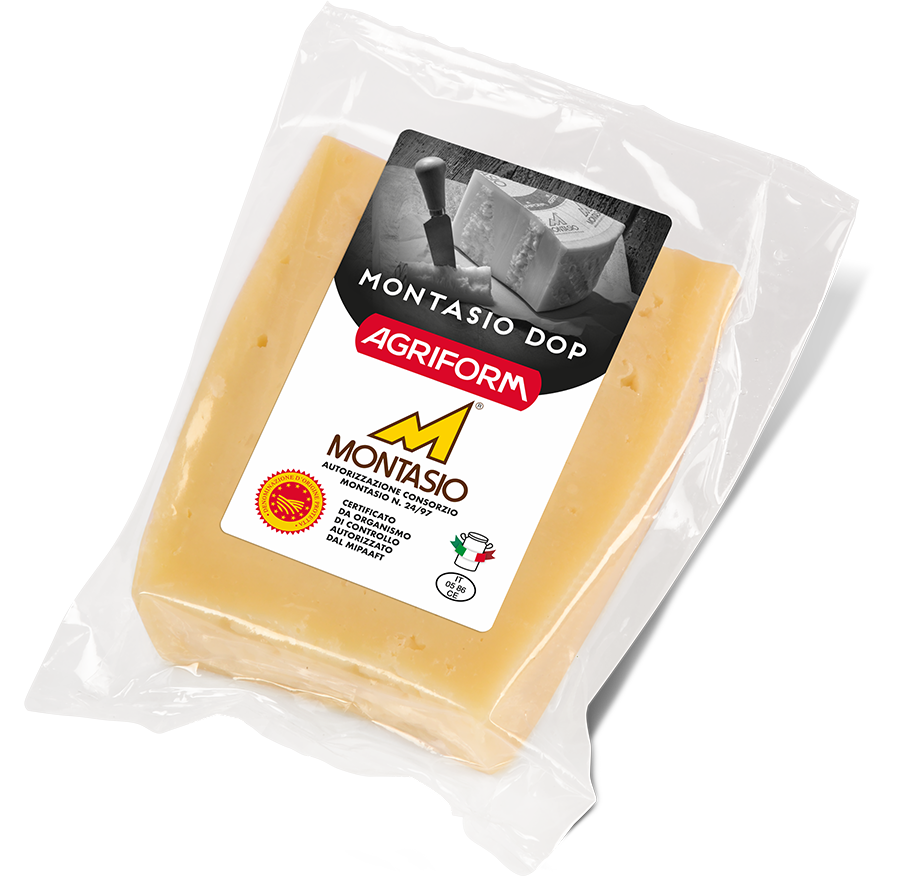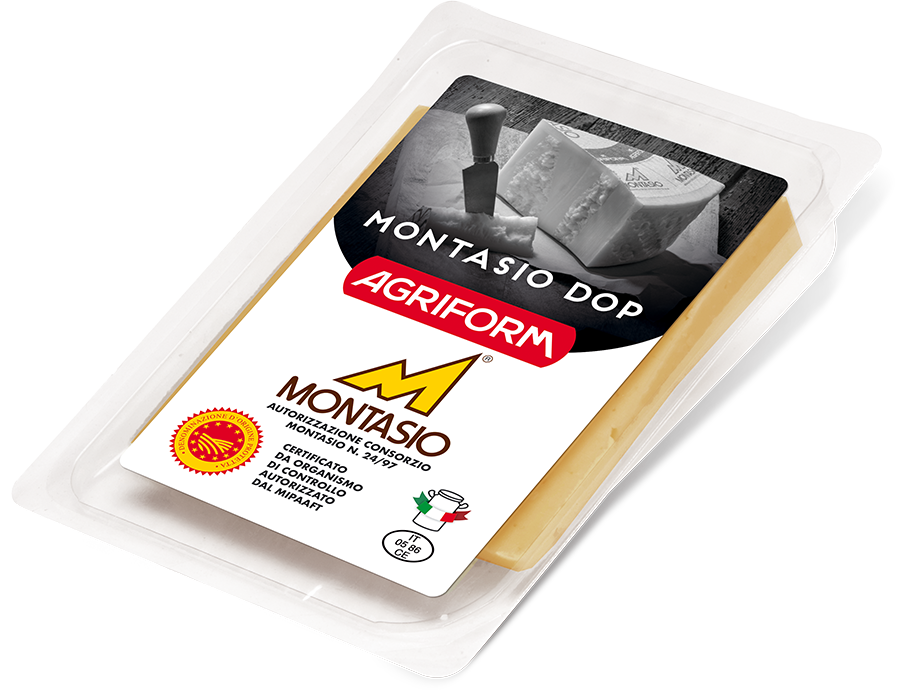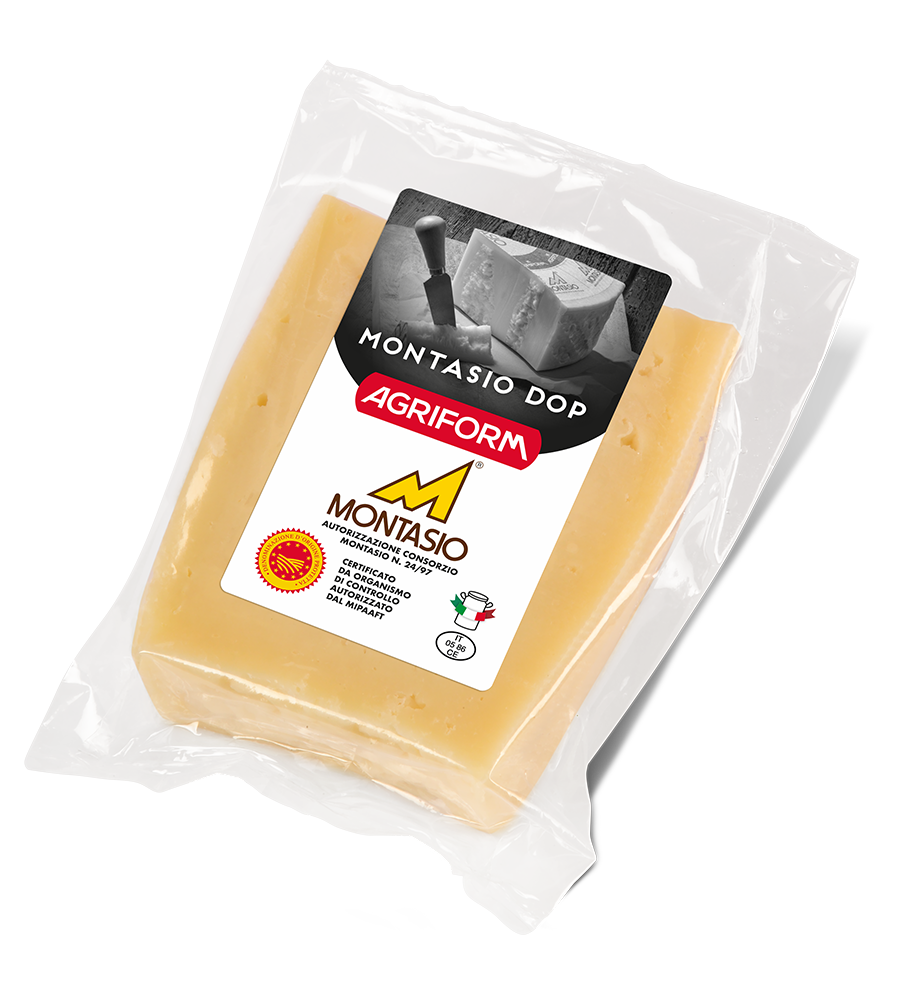
Montasio wheels
Piave whole wheels are perfect for Horeca.
Average weight: approx. 6-8kg
Dimensions: diameter 30/35 cm and height 7/9 cm
Average weight: approx. 6-8kg
Dimensions: diameter 30/35 cm and height 7/9 cm

Vacuum packed Montasio
Vacuum packagings allow the longest durability to Montesio wedges. The total absence of oxygen allows the product to be stored up to 6 months from the packaging date. Available in full or ¼ wheel for Horeca, and in 250g wedges for retail.

Montasio with thermoformed packaging
Thermoformed packagings come in rigid plastic tubs with resealable peel-off film, filled with modified atmosphere and a 4 month shelf life guaranteed.
Also available in flexible double-film easy-to-open vacuum packs for 180g slices with a 6 month shelf life.
Also available in flexible double-film easy-to-open vacuum packs for 180g slices with a 6 month shelf life.

Montasio in protective atmosphere
Wrapping Montasio under protective atmosphere (food level carbon dioxide and nitrogen) allows to bring to table a cheese slice as if it was just cut. Available in 250g slices and ¼ wheel cuts.
Montasio PDO
It is a typical table cheese from the region of Friuli Venezia Giulia and Northeastern Veneto.
It is a semi-hard cooked cheese, compact, white or straw-yellow in color with regular uniform holes. Initially the light brown coloured rind is smooth, elastic and compact, becoming dry over time. The paste becomes more close-textured and flaky as the cheese matures.
Three different types of Montasio are available: Fresco (young), Mezzano (semi-matured), and Stagionato (matured).
It is a semi-hard cooked cheese, compact, white or straw-yellow in color with regular uniform holes. Initially the light brown coloured rind is smooth, elastic and compact, becoming dry over time. The paste becomes more close-textured and flaky as the cheese matures.
Three different types of Montasio are available: Fresco (young), Mezzano (semi-matured), and Stagionato (matured).

Montasio wheels
Piave whole wheels are perfect for Horeca.
Average weight: approx. 6-8kg
Dimensions: diameter 30/35 cm and height 7/9 cm
Average weight: approx. 6-8kg
Dimensions: diameter 30/35 cm and height 7/9 cm

Vacuum packed Montasio
Vacuum packagings allow the longest durability to Montesio wedges. The total absence of oxygen allows the product to be stored up to 6 months from the packaging date. Available in full or ¼ wheel for Horeca, and in 250g wedges for retail.

Montasio with thermoformed packaging
Thermoformed packagings come in rigid plastic tubs with resealable peel-off film, filled with modified atmosphere and a 4 month shelf life guaranteed.
Also available in flexible double-film easy-to-open vacuum packs for 180g slices with a 6 month shelf life.
Also available in flexible double-film easy-to-open vacuum packs for 180g slices with a 6 month shelf life.

Montasio in protective atmosphere
Wrapping Montasio under protective atmosphere (food level carbon dioxide and nitrogen) allows to bring to table a cheese slice as if it was just cut. Available in 250g slices and ¼ wheel cuts.
PDO
Protected Denomination of Origin
DETAILS:
• Average weight of the wheel: 6-8 Kg
• Diameter: 30-35 cm
• Height: 8 cm
• Ingredients: milk, salt, rennet. Rind not edible
AGEING:
• Young: from 2 to 4 months
• Semi-matured: from 4 to 10 months
• Oro del Tempo: from 10 to 12 months
NUTRITION FACTS (FOR 100G):
Young Montasio
• Energy: 1644 kJ/396 kcal
• Fat: 32g
of which satures: 24g
• Carbohydrate: 0g
of which sugars: 0g
• Protein: 26g
• Salt: 1,9g
Protected Denomination of Origin
DETAILS:
• Average weight of the wheel: 6-8 Kg
• Diameter: 30-35 cm
• Height: 8 cm
• Ingredients: milk, salt, rennet. Rind not edible
AGEING:
• Young: from 2 to 4 months
• Semi-matured: from 4 to 10 months
• Oro del Tempo: from 10 to 12 months
NUTRITION FACTS (FOR 100G):
Young Montasio
• Energy: 1644 kJ/396 kcal
• Fat: 32g
of which satures: 24g
• Carbohydrate: 0g
of which sugars: 0g
• Protein: 26g
• Salt: 1,9g
Made exclusively from fresh cow's milk harvested in the area of production. Collected from two different daily milkings, with successive skimming of the evening milk, this milk is transformed into cheese using mild techniques that do not disrupt the original microbial flora and bacteria. To guide the fermentation a low-acidity starter bacteria is used, which is obtained through the fermentation of milk after low-heat pasteurization (heated milk).
Montasio gets its name from a group of mountains between the Resia valley and the Canale del Ferro (the iron channel) in the Friuli highlands and belongs to the large category of alpine cheeses. Originating around the year 1000, these cheeses served the purpose of storing an easily perishable product such as milk for periods when production was low or non-existent.
It originated around 1200 when Benedictine monks from the Moggio Udinese Abbey refined the various production techniques of local cheesemakers. This production technology quickly spread through the valleys of the Julian and Carnic Alps before arriving up to the Friuli-Veneto plain. Its diffusion was also encouraged by its proximity to the "Canale del Ferro", an important line of communication and trade route dating back to the Roman times.
The first documents that explicitly mentioned "Montasio Cheese" were price lists from the city of San Daniele dating back to 1775. Its presence in trading documents from Italian marketplaces and its high trade value, considerably greater than that of other cheeses, are proof of this product’s high regard and value.
In the last century, Guglielmo Ghinetti described in one of his literary works the diffusion of this delicious cheese from the foothills of the mountains to the plains. A diffusion that increased by the construction of the first cooperative dairies in 1880, with the opening of the first by the master Eugenio Caneva di Collina.
In 1925 the first dairy school was founded in San Vito al Tagliamento. This school has trained generations of technicians who have spread the art of producing Montasio cheese throughout the surrounding provinces for many years.
It was awarded the Protected Designation of Origin status in 1996.
It originated around 1200 when Benedictine monks from the Moggio Udinese Abbey refined the various production techniques of local cheesemakers. This production technology quickly spread through the valleys of the Julian and Carnic Alps before arriving up to the Friuli-Veneto plain. Its diffusion was also encouraged by its proximity to the "Canale del Ferro", an important line of communication and trade route dating back to the Roman times.
The first documents that explicitly mentioned "Montasio Cheese" were price lists from the city of San Daniele dating back to 1775. Its presence in trading documents from Italian marketplaces and its high trade value, considerably greater than that of other cheeses, are proof of this product’s high regard and value.
In the last century, Guglielmo Ghinetti described in one of his literary works the diffusion of this delicious cheese from the foothills of the mountains to the plains. A diffusion that increased by the construction of the first cooperative dairies in 1880, with the opening of the first by the master Eugenio Caneva di Collina.
In 1925 the first dairy school was founded in San Vito al Tagliamento. This school has trained generations of technicians who have spread the art of producing Montasio cheese throughout the surrounding provinces for many years.
It was awarded the Protected Designation of Origin status in 1996.
The production area for Montasio cheese covers two regions:
- Friuli Venezia Giulia: the entire territory of the provinces of Udine, Pordenone, Gorizia and Trieste;
- Veneto: the entire territory of the provinces of Treviso and Belluno and part of the provinces of Venice and Padova.
- Friuli Venezia Giulia: the entire territory of the provinces of Udine, Pordenone, Gorizia and Trieste;
- Veneto: the entire territory of the provinces of Treviso and Belluno and part of the provinces of Venice and Padova.
Matured Montasio (or “Vecchio”) Oro del Tempo is a typical table cheese from the Friuli Venezia Giulia region and northeastern Veneto that is aged at least 10 months. It is a semi-hard, compact, cooked cheese that is white or straw-yellow in colour with regular, even holes. It is distinguished by its very aromatic and pleasantly sharp flavour. Great by itself as a tantalizing appetizer or as an entrée; when grated it stylishly adds flavour to first and second courses. It pairs nicely with robust, full-bodied red wines like Refosco dal Peduncolo Rosso.
Extremely versatile in the kitchen, Montasio cheese lends itself well to many dishes, depending on the ageing:
- Fresco and Mezzano goes well on bread, in salads, with sliced cooked vegetables, in salty strudels, flans and vegetable quiches. It’s also a table cheese to be eaten alone, with bread or with raw or cooked vegetables. It combines nicely with polenta and fine meats. The Fresco variety pairs well with white wines (ex. Pinot bianco, Chardonnay); Mezzano is best when paired with Merlot.
- The Stagionato (matured) variety is an excellent cheese for grating and is also perfect for adding a touch more flavour to soups, ravioli and tortellini. This variety pairs nicely with full-bodied reds like Raboso del Piave.
- Fresco and Mezzano goes well on bread, in salads, with sliced cooked vegetables, in salty strudels, flans and vegetable quiches. It’s also a table cheese to be eaten alone, with bread or with raw or cooked vegetables. It combines nicely with polenta and fine meats. The Fresco variety pairs well with white wines (ex. Pinot bianco, Chardonnay); Mezzano is best when paired with Merlot.
- The Stagionato (matured) variety is an excellent cheese for grating and is also perfect for adding a touch more flavour to soups, ravioli and tortellini. This variety pairs nicely with full-bodied reds like Raboso del Piave.
